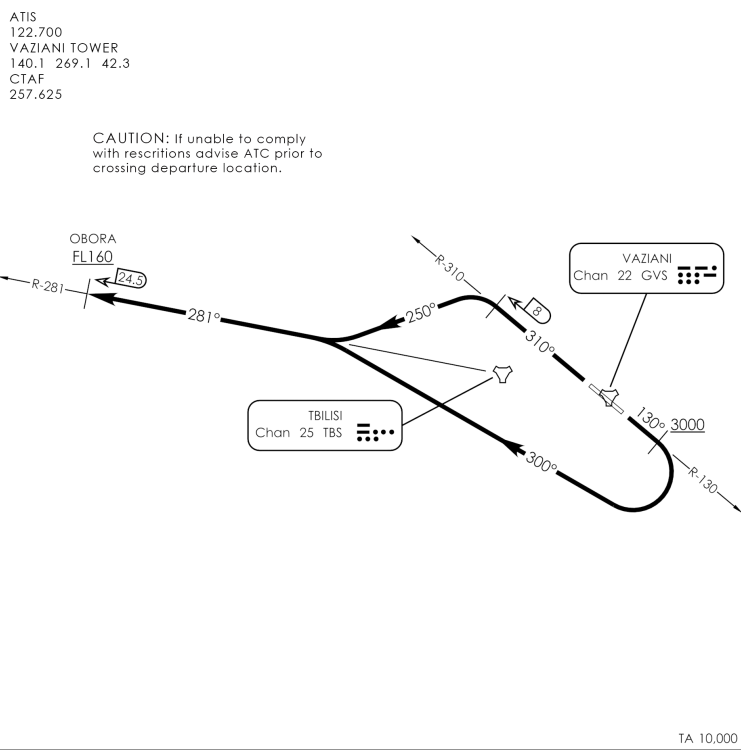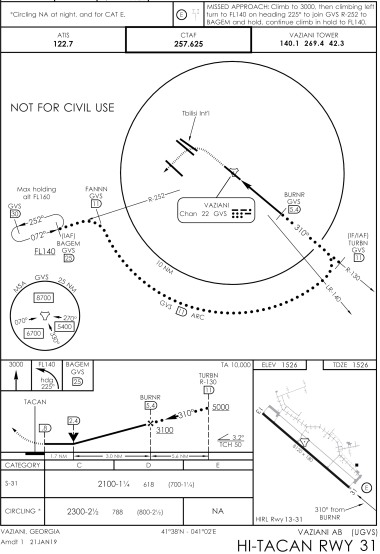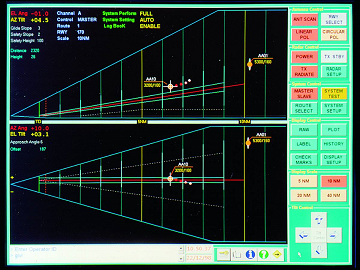Radio Communication
| Site: | Open Flight School |
| Course: | Advanced Theory (General) |
| Book: | Radio Communication |
| Printed by: | Guest user |
| Date: | Monday, 15 December 2025, 7:32 PM |
1. Radio Traffic from Parked to Take-off
To ensure a smooth process at the airport, it is necessary to adhere to some rules. The safety of all participants in air traffic is only guaranteed if all take part in the proper course of radio traffic. Here we show an example from engine start to take-off.
Station
P: Pilot
T: Tower
GC: Ground Control
Following radio communication takes place between pilot and Ground Control. If the airport does not have a GC, the tower is responsible.
| Station | English |
| P | Kutaisi Tower, Hornet 25, Request Start |
| T / GC | Hornet 25, Clear Start |
| P | Start, Hornet 25 |
| Station | English |
| P | Kutaisi Tower, Hornet 25, Request Altimeter (or Request QNH) |
| T / GC | Hornet 25, altimeter setting is 101 (or QNH 30.06) |
| P | QNH 30.06, Hornet 25 |
| Station | English |
| P | Kutaisi Tower, Hornet 25, request taxi |
| T / GC | Hornet 25, taxi to hold short of runway 26 via ROMEO, NOVEMBER and DELTA |
| P | Taxi to hold short of runway 26 via ROMEO, NOVEMBER and DELTA, Hornet 25 |
| Station | English |
| GC | Hornet 25, contact Kutaisi Tower, 134.000 |
| P | Contact Kutaisi Tower, 134.000, Hornet 25 |
| Station | English |
| P | Kutaisi Tower, Hornet 25, holding short of runway 26, ready for depature |
| Station | English |
| T | Hornet 25, hold short |
| P | Hold short, Hornet 25 |
| Station | English |
| T | Hornet 25, line up runway 26 and wait |
| P | Line up runway 26 and wait, Hornet 25 |
| Station | English |
| T | Hornet 25, wind 310 degrees, 9 knots, runway 26, clear for take-off |
| P | Cleared Take-off runway 26, Hornet 25 |
| Station | English |
| T / GC | Hornet 25, taxi to holding point runway 15 via BRAVO and DELTA, hold short of runway 23 |
| P | Taxi to holding point runway 15 via BRAVO and DELTA, hold short of runway 23, Hornet 25 |
| T / GC | Hornet 25, cross runway 23, report ready (for departure) |
| P | Cross Runway 23, Hornet 25 |
2. Radio Traffic VFR Approach, Landing to Parking
Um am Flughafen einen reibungslosen Ablauf zu gewährleisten, ist es nötig sich an einige Regeln zu halten. Die Sicherheit aller Teilnehmer am Flugverkehr ist nur garantiert, wenn sich alle am ordnungsgemäßen Ablauf des Funkverkehrs beteiligen. Hier zeigen wir ein Beispiel vom Anflug auf einen Flughafen bis zur Landung und Rollen in Parkposition unter VFR (visual flight rules / Sichtflug) Bedingungen.
Station
P: Pilot
ATC: Air traffic control (Flugverkehrskontrolle / Fluglotse)
T: Tower
GC: Ground Control
To ensure a smooth process at the airport, it is necessary to adhere to some rules. The safety of all participants in air traffic is only guaranteed if all take part in the proper course of radio traffic. Here we show an example from approaching an airport to landing and taxiing in parking position under VFR (visual flight rules) conditions.
Station
P: Pilot
ATC: Air traffic control
T: Tower
GC: Ground Control
| Station | English | English |
| P | Kutaisi Tower, Hornet 25 | Kutaisi Tower, Hornet 25 |
| ATC / T | Hornet 25, Kutaisi Tower | Hornet 25, Kutaisi Tower |
| Station | English | English |
| P | Hornet 25, 20 nm south, altitude 5000 ft, for visual recovery via SIERRA | Hornet 25, 20 nm south, 5000 feet, request entry into control zone for landing over SIERRA |
| ATC / T | Hornet 25, Clear visual approach via SIERRA, wind 080, 9 knots, runway 08, QNH 30.04 | Hornet 25, fly into control zone over SIERRA, wind 080, 9 knots, runway 08, QNH 30.04 |
| P | Hornet 25, visual approach via SIERRA, for 08, 30.04 | Hornet 25, fly to the control area over SIERRA, runway 08, QNH 30.04 |
| Station | English | English |
| P | Hornet 25, SIERRA, altitude 2000 ft | Hornet 25, SIERRA, Height 2000 feet |
| Station | English | English |
| P | Hornet 25, descend altitude 1500 ft, heading 300 | Hornet 25, they sink to 1500 feet and fly direction 310 |
| ATC / T | Hornet 25, descend altitude 1500 ft, heading 300 | Hornet 25, sink to 1500 feet, direction 310 |
| Station | English | English |
| P | Hornet 25, 20 nm south, altitude 5000 ft, for landing | Hornet 25, 20 nm south, 5000 feet, for landing |
| ATC / T | Hornet 25, enter controlzone from south, wind 080, 9 knots, runway 08, QNH 30.04 | Hornet 25, fly into the control zone from south, wind 080, 9 knots, runway 08, QNH 30.04 |
| P | Hornet 25, will enter controlzone from south, runway 08, QNH 30.04 | Hornet 25, fly into the control area from south, runway 08, QNH 30.04 |
| Station | English | English |
| ATC / T | Hornet 25, traffic west of the airfield, tow Tomcats | Hornet 25, traffic west of airport, two Tomcats |
| P | Hornet 25, traffic in sight | Hornet 25, traffic in sight |
3. Instrumenten Start, Abflug, Rückkehr zur Basis, Anflug, Landung
Nun kann es durchaus vorkommen, dass das Wetter einen VFR Abflug nicht zulässt. Hier zeigen wir nun ein Beispiel am Flugplatz Vaziani unter Intrumentenflugbedingung kurz vor dem Start direkt nach dem Rollen (siehe vorheriges Kapitel).
Die IFR Erlaubnis erbittet man normalerweise schon sehr früh bei der Erlaubnis zum Triebwerksstart. Es kann aber auch sein, dass es noch dauert bis die Freigabe erteilt wird. Daher könnte der Funkverkehr kurz vor dem Start wie folgt aussehen.
Der Sprechfunk unter Instrumentenflugbedingung ist immer auf Englisch. Um die Verständnis zu erleichtern, hier aber auch die deutsche Übersetzung.

Station
P: Pilot
ATC: Air traffic control (Flugverkehrskontrolle / Fluglotse)
T: Tower
GC: Ground Control
|
Station |
Englisch |
Deutsch |
|
T / GC / |
Hornet 25, cleared to XXXXX via Obora1 Departure, climb FL 180 unrestricted, Squawk 1234, Contact Departure on:257.625, read back |
Hornet 25, Freigabe bis zum Trainingsgebiet XXXXX, gemäß dem Abflugverfahren Obora 1, steigen sie auf Flugfläche 1 8 0, uneingeschrängter Steigflug Transponder auf 1234, Kontaktieren sie nach dem Abheben Abflugkontolle auf 257.625, lesen sie zurück |
|
P |
Hornet 25, is cleared to XXXXX via Obora1, climbing 180, unrestricted, Squawk is 1234, Departure on 257.625 |
Hornet hat Freigabe bis XXXXX via Obora 1 Steigen auf Flugfläche 180, Transponder ist 1234, Kontaktiere Abflugkontrolle auf 257.625 |
|
T / GC |
Read back correct, cleared for departure, Wind is 290/15, have a good Flight |
Das Zurücklesen war korrekt, Sie haben Startfreigabe, der Wind kommt aus Richtung 2 9 0 mit 15, |
|
P |
Cleared for Departure, Cya |
Freigabe zum Abflug, Schönen Tag noch* |
*obwohl immer gemeint wird, unnötiges Gerede ist zu vermeiden, ist dies nicht der Fall, Menschen arbeiten mit Menschen und eine kurze knappe Begrüßung oder Verabschiedung ist immer gern gesehen.
|
Station |
Englisch |
Deutsch |
|
P |
Vaziani Departure, Hornet 25 airborne, passing 2500, Climbing 180 inbound XXXXX |
Vaziani Abflug, Hornet 25 steigt gerade durch 2500 fuß, weiterer Steigflug auf Flugfläche 180, in Richtung XXXXX |
|
DEP |
Hornet 25, Radar Contact, continue Climb 240. Turn right Heading 300, when leveling off contact Magic on 321.755 |
Hornet 25, Radar Kontakt, steigen sie weiter auf Flugfläche 240, Drehen sie nach rechts auf Steuerkurs 300. Nach erreichen der Flugfläche 240 kontaktieren sie Magic auf Frequenz 321.755 |
|
P |
Vaziani, Hornet approaching XXXXX, request Switching Tactical. |
Vaziani Abflug, Hornet 25 nähere mich dem Trainingsgebiet. Erbitte wechseln zu Taktischer Frequenz |
|
Station |
Englisch |
Deutsch |
|
P |
Vaziani Approach, Hornet 25 Level 250, inbound YYYYY request descend to 5000 |
Vaziani Anflug, Hornet 25 in Flugfläche 250, Richtung YYYYY, erbitte Sinkflug auf 5000 fuss, |
|
APPROACH |
Hornet 25, Radar Contact, interested in Latest VazianiWeather? |
Hornet 25, Radar Kontakt, benötigen Sie das Aktuelle Wetter in Kutaisi |
|
P |
Vaziani, Hornet go ahead. |
Vaziani Abflug, Hornet bereit zur Aufnahme. |
|
APPROACH |
Vaziani information Z is current, Runway 31 in use, Met report 15:20 wind 290/15, visibility more than 10, sky clear, temperature 22, Dewpoint 10, QNH 29.92 NoSIG, VazianiInformation Z |
Vaziani Wetter Information Z , Landebahn 31, Uhrzeit 15:20, wind aus 280 mit 15 Knoten, Sicht mehr als 10 Kilometer, keine Wolken, Temperatur 22, Taupunkt 10, QNH 29.92, Keine Deutlichen Veränderungen. VazianiInformation Z |
|
P |
Hornet 25, Copy, Runway 31, QNH 29.92. Request Vektors For ILS (NDB/PAR) at Vaziani(Vectors to Initial/Inbound Entry Point) |
Hornet 25, Verstanden, Landebahn 24, QNH 29.92. Erbitte Vektor für einen ILS Anflug Piste 31. (Vektoren für AnflugPunkt) |
|
APPROACH |
Hornet 25 turn initially 270, descend 5000. Contact Precision /Tower on 140.500 |
Hornet 25, drehen sie auf Steuerkurs 270, sinken sie auf 5000 fuß. Kontaktieren sie Radaranflug Kontrolle auf 140.500, |
|
P |
Hornet 25 270, descending 5000, Wilco |
Hornet 25, drehe auf 270 und sinke auf 5000, verstanden. |

